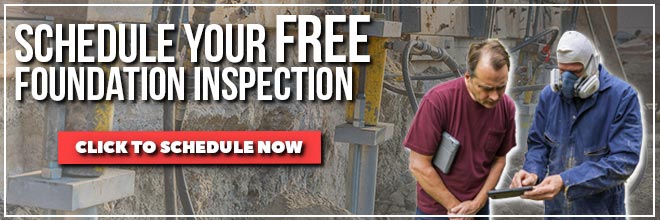Maybe a foundation repair contractor recently wriggled out of your claustrophobic crawlspace, brushed off the cobwebs, and said you have a serious crack in your stem wall. And, maybe, your first thought was that sounds pretty bad, but what the heck is a stem wall and why should I be worried? If you want to learn exactly what a stem wall foundation is and how it functions, this article is for you.
Dalinghaus Construction Inc. has serviced thousands of foundations in Southern California and Arizona, holding over 100 years of collective foundation repair experience. We’ve worked on every type of foundation imaginable and have spent a fair share of our time inspecting and repairing stem wall foundations.
This article covers the definition of a stem wall foundation, common stem wall problems, and prevalent stem wall repairs.
What is a Stem Wall Foundation?
Stem wall foundations are a type of raised foundation that was first utilized because they proved considerably cheaper than a basement or slab-on-grade foundation due to less cement usage. Stem wall foundations are comprised of a raised cement perimeter. Stem wall foundations can be implemented with post and pads or further interior cement walls/support.
Stem walls are generally 18 inches to 2 feet above grade, with another foot to foot-and-a-half buried underground for support (this underground section is referred to as a footing). Once the subfloor is attached, this vertical space/cavity is referred to as a crawlspace.
Note – while crawlspaces exist that are smaller than 18 inches in height, these prove incredibly difficult to maneuver and many foundation repair companies will refuse to inspect/repair due to insufficient room.
Generally, stem wall foundations are created by utilizing cinder blocks reinforced with steel rebar poured over with concrete. This cement outline/perimeter provides the perfect space for the home walls to be attached to.
In short, the stem wall foundation is a type of raised foundation, comprised of cement walls, that provides structural support by transmitting the load of the home to the footing and often keeps the home above flood level.
What are Common Problems with Stem Wall Foundations?
Stem wall foundations, just like all other types of foundations, are susceptible to general disrepair from poor soil conditions and environmental factors. Common problems with stem wall raised foundations include:
- Stem wall concrete spalling – stem wall concrete spalling can best be thought of as “cement rot.” Spalling is the breakdown of concrete via natural weathering/chemical reactions that result in chipped, fractured, and structurally compromised concrete. Spalling is often caused by poor drainage
- Stem wall exposed rebar – stem wall exposed rebar indicates serious water damage and can indicate a section of your stem wall/footing is about to break off. Rust expands and creates pressure as it swells, breaking apart the already weakened concrete.
- Stem wall cracks – stem wall cracks can be indicative of water damage, damage from seismic activity, and/or foundation settlement.
People commonly refer to a stem wall and a stem wall foundation footing as one and the same. In the foundation repair industry, the interior of the crawlspace is referred to as the stem wall and the exterior is referred to as the footing. While the distinction is just semantics, is incredibly helpful to know exactly what your foundation repair specialist is referring to in order to understand the scope of the damage.
It’s important to address the stem wall issues above as soon as possible to ensure the structural integrity of your home does not deteriorate further. Concrete stem walls are similar to teeth in that cavities/cracks can quickly corrode into larger, more expensive fixes if not addressed ASAP.
Check out our blog – Vertical Wall Cracks: Causes And Repair Options
Common Repairs for Stem Wall Foundations
Stem wall repairs are imperative to secure the stability of your foundation and home. Here are some common forms of stem wall foundation repair:
- Stem wall foundation underpinning – Foundation settlement is caused by incompetent, non-load-bearing soils that allow a structure to sink/settle, exerting a tremendous amount of force/stress upon a home’s foundation. Push pier and helical pier underpinning are common forms of stem wall settlement repair. Underpinning returns the home to level and mitigates further settlement.
- Stem wall carbon fiber crack repair – Carbon fiber crack repair with carbon fiber staples and carbon fiber wraps are a common choice in repairing cement fractures. Carbon fiber is stronger than Kevlar and is utilized in conjunction with epoxy. These repairs can usually be completed in a day and return the strength to your foundation.
- Stem wall seismic retrofitting – Stem wall foundations can be seismically retrofitted (brace-and-bolted) to reinforce the home against anticipated seismic activity.
Read more: How To Repair Your Concrete Foundation That’s Crumbling
Need to Know More about Stem Wall Foundation Repair?
This article covered the definition of a stem wall foundation, common problems (spalling, exposed rebar, and cracks), and common stem wall repairs (underpinning, crack repair, and seismic retrofitting).
Dalinghaus Construction Inc. has been in the foundation repair game since 2015. We’re glad we could eliminate any confusion regarding stem wall foundations.
If you have a stem wall foundation and/ or would simply like to learn more about stem wall repairs, read our articles Residential Seismic Retrofitting: Definition, Techniques, and 7 Steps.
If you would like to book a free stem wall foundation inspection and live in Southern California or Arizona, click the link below –








2 Responses
We need to raise our 1600 square foot house about five feet above grade. Can a stem wall foundation be that high?
Can a stem wall be installed on a existing home in Florida built on a concrete slab ?